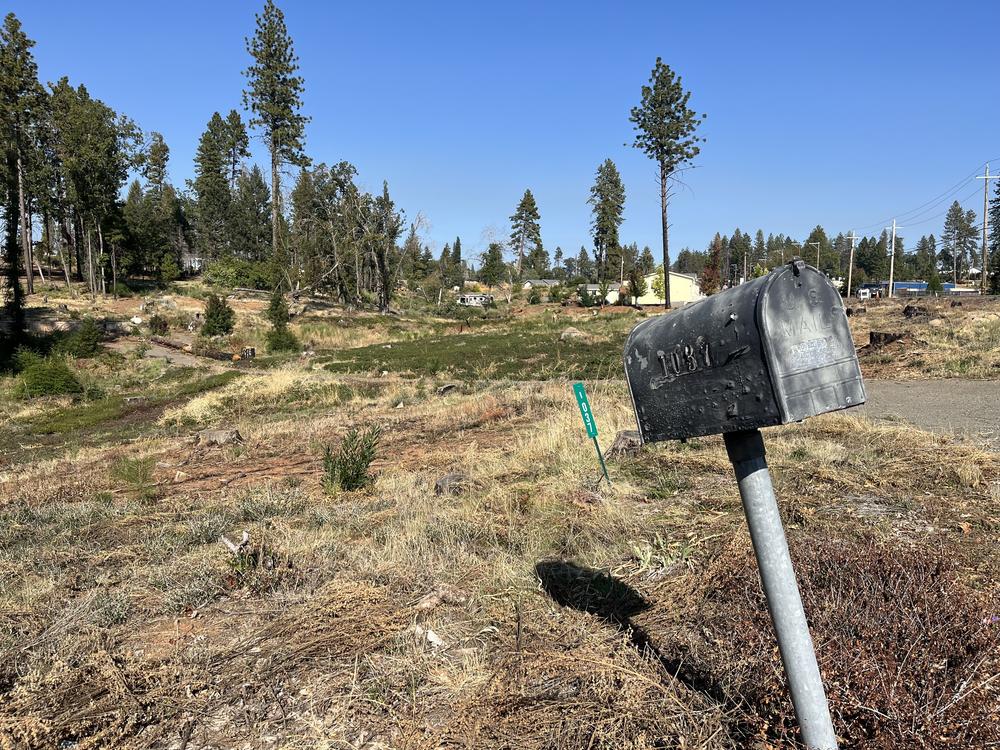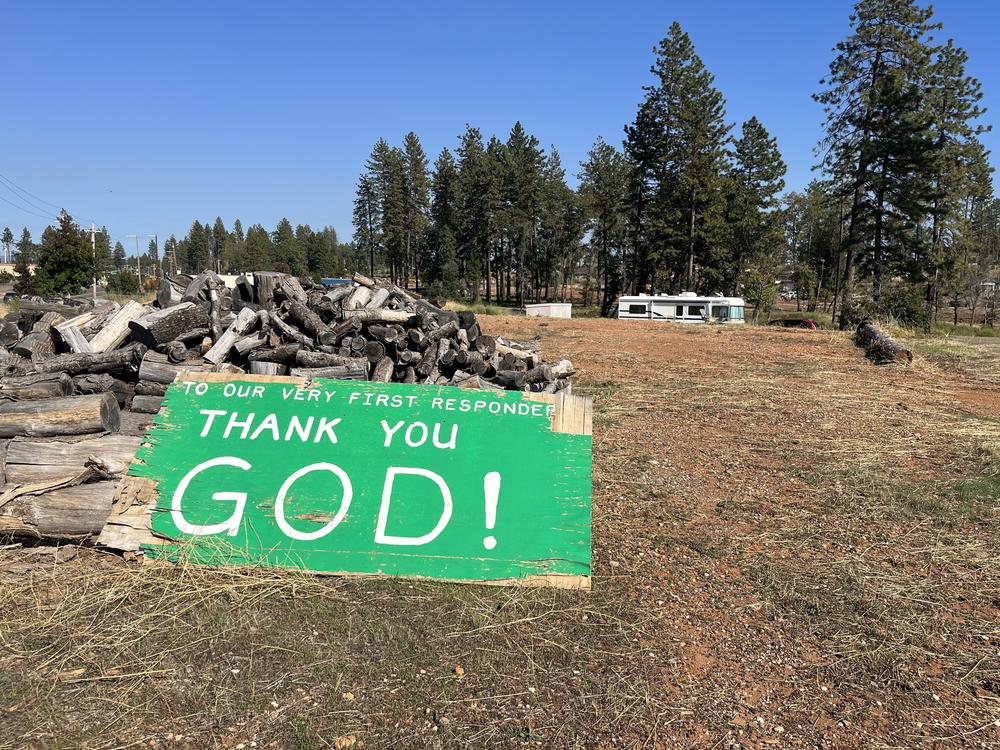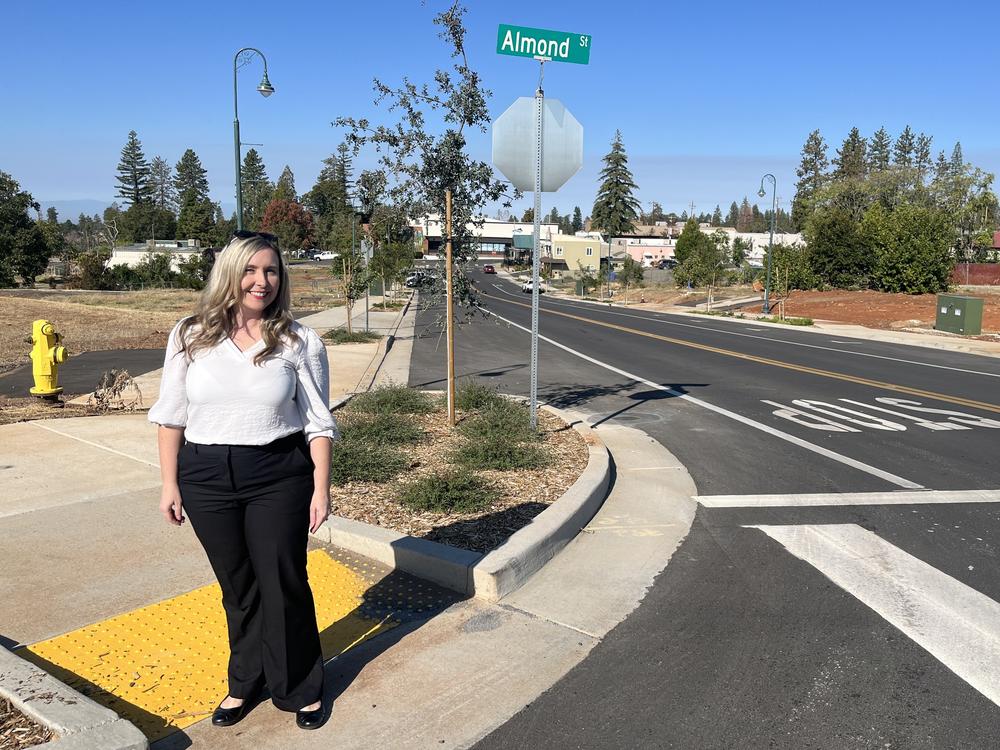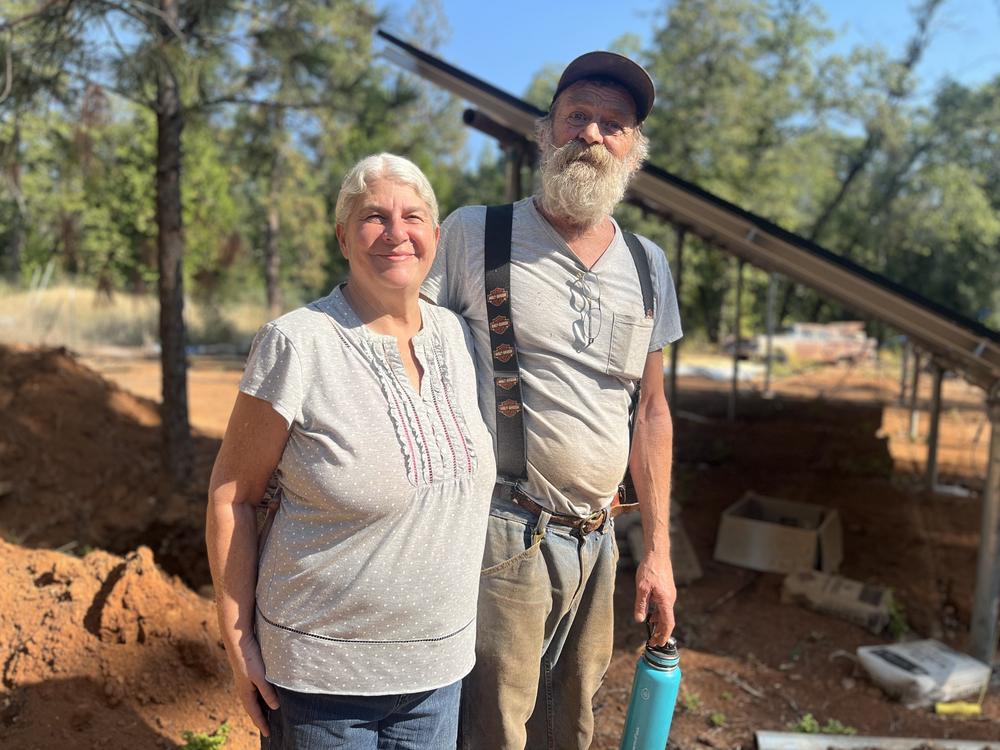Section Branding
Header Content
A California town wiped off the map by wildfire is still recovering five years on
Primary Content
Updated November 8, 2023 at 8:02 AM ET
PARADISE, Calif. — Cindy Foudray is trying to stay optimistic. But some days it's a struggle.
"I feel like I've aged like 20 years," she says, chuckling wryly. "It's just a lot of stress and a lot of things have happened."
Her life was completely upended in early November of 2018, amid one of the driest autumns on record in the Sierra Nevada, when the deadly Camp Fire swept into her hometown of Paradise, Calif., killing 85 people and destroying nearly 19,000 structures. The most expensive climate-related disaster in the world that year.
"There are positives," she says. "My family got out alive."
But Foudray's family home, a two-bedroom two-bath mobile, was a total loss.
Five years later, she's still mostly living in a RV on her burned out lot, hoping to get a new home within the next year.
"My heart goes out to people in Hawaii right now because we can totally relate to that," Foudray says. "I mean, we didn't have to jump in the ocean but trying to get off this mountain was really difficult during the fire."
Five years later only a third of Paradise has repopulated
As Paradise marks five years since one of the worst wildfires in American history — only the blazes on Maui last August were deadlier — many in the rural Northern California region are still coping with trauma and struggling to recover.
The slow and expensive recovery that continues today in Paradise could be a lesson for survivors in Lahaina, not to mention scores of other recent wildland fire disasters on the mainland like Marshall Canyon, Colorado and near Las Vegas, New Mexico.
Before the Camp Fire, which was ignited by downed powerlines in the National Forest lands northeast of town, about 26,000 people lived in Paradise. Now, it's estimated that it's roughly a third of its pre-fire population.
Depending on who you ask, it's a monumental feat considering 90% of the town was leveled, or it's an example of how a recovery from a major disaster can be prolonged and painfully slow despite billions in federal and state aid.
Paradise was affordable but that's inevitably changing
Paradise had been an island of relative affordability in expensive California. It also became dangerously overgrown with dense stands of pines and underbrush, in part due to loose zoning and prior forest management decisions.
In the 1950s and 1960s it was marketed as a "place in the pines" for retirees from the Bay Area, about a three-hour drive to the south.
Foudray is planning to stay in her camper this winter as much as she can. She can stay with family if her pipes freeze, like they did earlier this year. She's grateful to have found steadier work in the meantime as a home services aid.
"It's a slow process either way because when you're starting from scratch, you can only do what you can do at that moment and work forward," Foudray says.
In the weeks and months immediately after the Camp Fire, survivors were anxious to get home.
They soon became frustrated, angry about the slow pace of even just removing the fire debris.
Then as the months dragged on, the scope of what was ahead began to settle in.
It took nine months just to remove all the hazardous toxins and debris piles before the first homes could be rebuilt. Paradise's recovery had a lot stacked against it from the beginning due to its largely elderly and low-income population. Many were forced to leave in search of affordable housing.
"I don't know that there will ever be 26,000 people in Paradise again," says Ryan Miller, a geography and hazards expert at the University of California-Davis who has been interviewing Camp Fire survivors as part of a doctoral project.
Miller also grew up in Paradise. His brother, sister and mother narrowly survived evacuating on November 8th, 2018. His family lived there because they could afford to.
"I don't think it's up to the Paradises of California to provide the affordable housing anymore," Miller says.
Paradise locals say what they've accomplished so far is a miracle
One of the biggest changes since the fire that locals remark on nearly constantly are the views.
Originally built out into dense forests, Paradise today is a changed land. One million trees have been removed, the coastal range to the west and Sawmill Peak and the Sierra foothills to the east are now visible.
Roads are being newly paved or reconfigured and blocked by flaggers. Utility crews are digging trenches and burying all the new power lines underground. And main thoroughfares are clogged with construction traffic.
All the new homes have to meet tougher wildfire codes, including a new local ordinance that bans any porches or other fixtures built from combustible materials in the immediate perimeter of houses.
Paradise's former Mayor Jody Jones says Paradise is becoming one of the safest towns in California.
"We're building a resilient town that the people here care a lot about," Jones says.
Not easy in a rural area where there was a severe housing and labor shortage before the Camp Fire. Jones and her husband were among the first 100 survivors to secure new building permits and were able to rebuild and move back within two years of the fire. But she knows they're probably outliers.
In recent meetings with leaders in Lahaina, Hawaii, Jones has been advising that a disaster recovery in this era can take decades.
"It's a ton of work. It's not going to happen overnight," Jones says. "But considering it's only been five years and we had a pandemic in the middle of that, what we've accomplished is a miracle."
Paradise is now one of the largest construction sites in the world
Before the Camp Fire, Paradise typically saw about a dozen new homes built in any given year. Now, they're averaging 600, even with much tougher zoning. Town leaders tried to account for the rising costs by streamlining permitting, even offering pre-approved fire-wise design plans.
"We actually hear a lot from people outside of the community, saying, 'wow, this is taking a really long time,'" says Colette Curtis, recovery coordinator for the Town of Paradise. "Our perspective is we feel really good about the pace of this recovery."
Town leaders like to say that they're now existing in the largest construction site in the world.
They acknowledge that the new construction is pricing some people out. Housing costs were way lower when most of the homes on the ridge were built in the 1950s and 1960s. But you can't just put everything back how it was or there could be another Camp Fire.
"We could spend our time as human beings running from those disasters continually or we can spend our time learning how to live in these places in a resilient and safe way," Curtis says.
This costs a lot of money. And it turns out a lot of the aid coming into disaster areas — like the millions pouring into Lahaina right now — tends to go to rebuilding infrastructure, not individual private homes.
"We're not good at this in our country," says Ed Mayer, executive director of the Housing Authority for Butte County, which includes Paradise. "Our history of disasters, and no fault of their own, FEMA sort of has a one size fits all approach."
The U.S. government typically comes in and tries to help people find temporary housing quickly while disaster victims figure out how to rebuild. But Mayer says that doesn't work in states like California and Hawaii where there has been a worsening affordable housing crisis for years.
"Our wish at the very outset of this disaster was, hey, we want some soap bubble housing," Mayer says. "And when I say soap bubble housing, we want some housing we can erect tomorrow."
Still, five years later, Mayer's office is celebrating some successes. There are some 3,000 affordable housing units now in development in the county, thanks in large part to housing officials leveraging aid and various grants.
Most are not in Paradise, however, and officials say it's probably a fraction of what's actually needed. In the days after the fire, an estimated 35,000 displaced people flooded into nearby cities like Chico.
"To the degree with which you can't meet your immediate need, you're going to be working with either homeless or folks in some transitional status," Mayer says. "It can go on for years."
Paradise will always be home to a lot of people
Bernadette Grant feels like she's been in transition since 2018, moving around various places in Chico all the while wanting to be home in Paradise. Her apartment burned as did her mother's home which had been in the family for fifty years.
"Five years and I really thought at this point a lot more would be rebuilt," Grant says.
Frustrated, Grant and her partner Richard Fox eventually decided to try building on their own on a lot she owns outside Paradise that didn't burn in the Camp Fire.
They're now clearing out dense stands of ponderosa pine that pose a fire risk - many are diseased or dead from bark beetles - and milling them into lumber. They're also going off grid. They erected large solar panels a few yards from where their planned 1,200 square foot home will be built.
Many here are still angry it's taken survivors as long as it has to get settlement money from the utility PG&E, whose downed powerlines started the Camp Fire.
"A lot of people haven't been paid off for all the damages that's been done to them already," Fox says. "That's ridiculous, five years, they lost everything."
Grant called it a leap of faith to move back up here with the threat of more wildfires ever present. The two are living in an RV for now and plan to stay through the winter even when the snow falls.
They're not sure where else they could live that's not threatened by climate change, pointing to the recent deadly wildfires in the tropics.
"There's no place on earth that's perfect and completely safe," Grant says.
Copyright 2023 NPR. To see more, visit https://www.npr.org.





